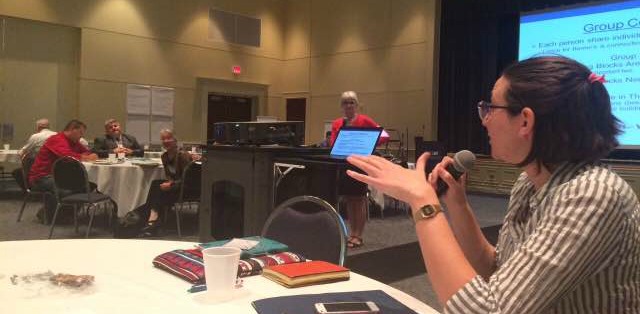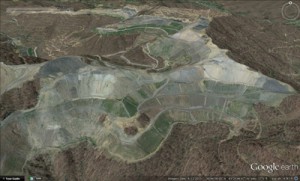Archive for June, 2015

CLICK on the image to sign the petition!
Jim Justice – target of the regional Justice to Justice campaign, recently expressed interest in becoming governor, much to the dismay of the thousands who have been cheated out of wages by Justice bad business practice, or had their communities damaged by outlaw mines he owns.
As Tom Torres, an activist with the Justice to Justice campaign and the group Hands Off Appalachia, says in this Grist article, “He has this public persona as a down-home charitable member of the community, and at the same time he owes millions of dollars to unpaid contractors and all these state and federal agencies for labor violations and environmental violations and safety violations.”
Sign this petition against Jim Justice‘s bad actions here to join the campaigning for him to clean up his mess and pay off his debts.
No comments yet » Leave your own...
Article by Gabby Gilliespie, Southwest Virginia oganizer with the Sierra Club Beyond Coal Campaign
Last week, citizens from across Appalachia attended a listening session hosted by the Appalachian Regional Commission in Morehead, Kentucky. With the provisions proposed by Obama for the 2016 budget, organizers in Appalachia are attempting to create a groundswell on many levels that will push local leaders to make good decisions for the future of Appalachia. A part of these provisions, known as the POWER+ Plan, include a proposed $25 million in funding to the Appalachian Regional Commission (ARC). As many know, the ARC has a lot of influence when it comes to economic development in the region. They have been a part of shaping conversations and building partnerships for the past fifty years. As a young citizen of Appalachia, I believe it is important for as many of us as possible to participate when ARC hosts listening sessions and public forums, so that our voices are heard and our ideas are propelling these conversations forward.

Ada Smith, of Appalshop and The STAY Project, speaks
The ARC scheduled five listening sessions across Appalachia to gather public input on their 2016-2020 Strategic Plan. Before hosting these events, the ARC put together a study detailing the impacts of the initiatives put in place by their organization over the past fifty years. These listening sessions are the next step in the process towards creating a strategy that includes the input of citizens, leaders, and representatives from varied sectors that will be impacted by the work of the ARC.
Carol Judy from the Clearfork Valley in Tennessee said, “At the Morehead meeting there was a significant presence of youth who shared and participated, creating an intergenerational sharing of solutions and issues,” and the question she has moving forward is, “where is the youth of ARC?” Coming out of this session, I also heard a lot of questions about how citizen input was meant to be incorporated. How much sway do our ideas truly have on the strategic plan?
The structure of the listening session began with a welcome and briefing about the strategic plan, as well as the findings from the Executive Summary mentioned above and located at this link, entitled “Appalachia Then and Now: Examining Changes to the Appalachian Region Since 1965.” After these presentations, the facilitation team asked participants to get into groups and share their understandings of opportunities to strengthen the economies in their communities. In that same session folks were asked to discuss the specific barriers they see to advancing those opportunities. People were given space to share within their small groups, and also share out to the entire assembly the things that resonated during their conversations. In the next session the questions involved the building blocks and resources people felt they had in their communities and which building blocks were lacking or needed strengthening.
Kendall Bilbrey, a young citizen from Southwest Virginia felt that, “Folks seemed to be comfortable with solutions-based conversations without getting caught up in political arguments,” and believes that these conversations are vital to moving our region forward to work together toward just transition.
We have seen a lot of progress on this front in Central Appalachia over the past five years. It seems that more and more citizens every day are willing to let the “coal is our future” rhetoric fall to the wayside and are far more open to talk about new economic opportunities in the region. Many folks in the groups I engaged in at the event wanted to see more spaces for sharing intergenerational knowledge and skills, as well as seeing much more youth engagement.
Overall, I believe events like the ARC listening sessions are a good opportunity for communities across the region to come together and share ideas for the future as well as discuss issues concerning the roles organizations have and should play in shaping the economic landscape of Appalachia.
To learn more about these listening sessions, visit the ARC website.
No comments yet » Leave your own...
Cross-posted from AppVoices.org

As even some of the largest U.S. coal producers run the risk of caving under their debts, officials that oversee the federal surface mine bonding program are voicing urgent concerns about companies’ ability to pay for post-mine reclamation.
After bankruptcies, legal fees, fines, plummeting share prices and years without a profit in sight, another aspect of the financial perils U.S. coal companies face is coming into full view.
Recently, regulators worried about the ability of coal companies to pay for post-mine reclamation have begun scrutinizing a practice known as “self-bonding,” which allows a company to insure the cost of restoring the land after mining without putting up collateral, provided it meets certain financial criteria.
Reuters reported last week that Peabody Energy, the world’s largest private-sector coal company, is under the microscope and may be violating federal bonding regulations under the 1977 Surface Mine Control and Reclamation Act.
Peabody, which reported a $787 million loss in 2014, had roughly $1.38 billion in clean-up liabilities insured by self-bonding at the end of March, according to the report. In fact, as its finances deteriorate, analysts say Peabody is warping the language of the law and pointing to the relative strength of its subsidiaries’ balance sheets to continue meeting self-bonding requirements.
Peabody is not alone. Arch Coal, which Reuters found has also failed the financial test to meet self-bonding requirements, is restructuring its multibillion-dollar debt. The company ended 2014 with $418 million in cleanup liabilities and hasn’t turned a profit since 2011.
On May 29, Alpha Natural Resources received word from the Wyoming Department of Environmental Quality that it is no longer eligible to self-bond in the state. The company now has less than 90 days to put up $411 million in anticipated mine cleanup costs. The nation’s second-largest producer by sales, Alpha told investors earlier this year that it had $640.5 million in reclamation liabilities at its mines in Appalachia and Wyoming’s Powder River Basin.
Watching as even some of the largest U.S. coal producers run the risk of caving under their debts, officials that oversee the federal bonding program are voicing urgent concerns to state officials.
In April, the U.S. Office of Surface Mining Reclamation and Enforcement sent a letter to West Virginia Department of Environmental Protection urging that the state conduct a fuller analysis of future risks �” not just rely on historic data �” to calculate reclamation costs.
“Given the precarious financial situation” of companies operating in West Virginia, the letter states, regulators should closely examine the risk of failure for sites with markedly more expensive liabilities such as pollution treatment facilities.
From where we’re standing, it’s tough to see how the situation could improve. Taken together, the country’s four largest coal companies �” Peabody, Alpha, Arch Coal and Cloud Peak Energy �” have about $2.7 billion in anticipated reclamation costs covered by self bonding. Bloomberg News reported in March that nearly three quarters of Central Appalachian coal is mined at a loss.
As the problem grows, regulators and advocates for reform face their own predicament. Stricter self-bonding standards and enforcement push cash-strapped companies closer to bankruptcy. But inaction could leave taxpayers to pick up the bill if companies with unreclaimed mines eventually crumble.
No comments yet » Leave your own...
Last week, our friend Dustin White traveled back to Washington, DC to speak up for the mountains. The House Committee on Natural Resources was having an Oversight Hearing on “State Perspectives on the Status of Cooperating Agencies for the Office of Surface Mining’s Stream Protection Rule.” At issue in this hearing is the cooperation between the state and federal government on the protection of Appalachian streams and the development of the anticipated Stream Protection Rule that the Office of Surface Mining has been developing since 2009.

Dustin captured the issue well,
Most of the Appalachian states with mountaintop removal have their own regulatory agencies that are supposed to be the first line of defense for communities when coal companies violate the law. These agencies exist in KY, VA, and in WV we know them as the DEP or Department of Environmental Protection. But many in WV say DEP stands for something else… “Don’t Expect Protection” as citizens often find themselves doing the job of the DEP to monitor the impacts of mining. We have found that the state regulatory agencies often issue mining permits against objection of citizens and sometimes without the proper environmental surveys required by law. They often allow coal companies that are habitual violators of the law to operate with little to no interruption. Fines issued for violations are little more than pocket change for coal companies.
In at least WV and KY the regulatory agencies and state legislatures worked lower water quality standards that go against federal guidances, allowing companies to discharge higher levels toxic selenium and aluminum into streams. Agencies like the DEP seem to be working against the best interest of the people and because of this citizens often turn to legal action to reign in coal companies. We have even filed a 733 petition under SMCRA in WV asking OSMRE to intervene in DEP’s mining division for failing to do their job.
The lack of protection many communities face when mountaintop removal threatens their water has been blamed, in part, on lack of oversight by state agencies. Therefore many have looked to the federal government and to Congress to protect their land and water from this devastating practice.
Thanks to Dustin for taking time out of his busy work organizing with people who’ve seen the worst impacts of the coal industry and sharing his experience with those in DC! Let’s hope that those in charge of enforcing the law in West Virginia were listening in.
No comments yet » Leave your own...













